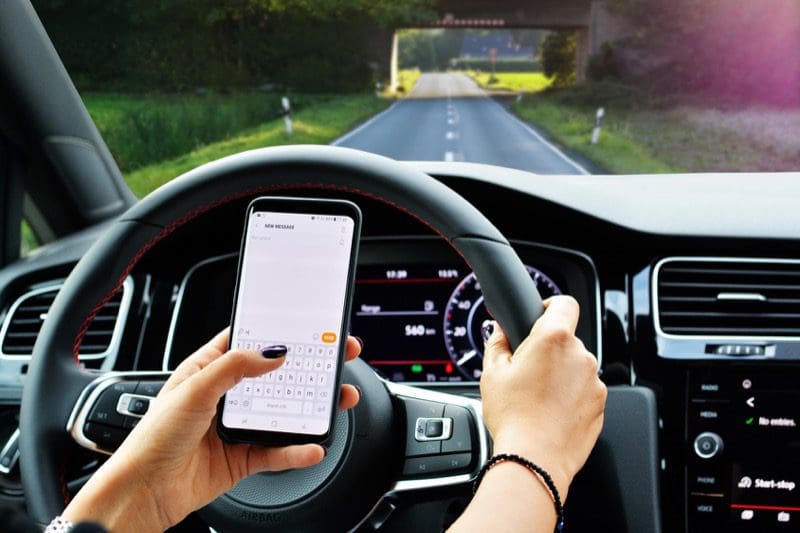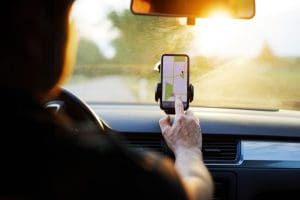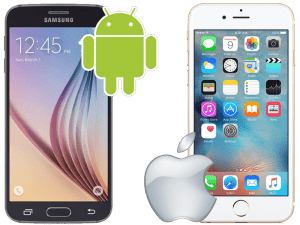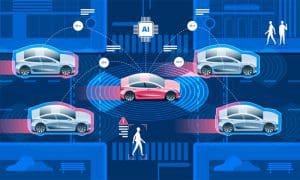 In 1982, Michael Knight was able to talk to his 1982 Pontiac Firebird and ask it for navigation directions. Of course, watching “Knight Rider” meant that we understood that KITT was make-believe. Fast-forward 35 years, and talking to our vehicles is now a reality, thanks to our smartphone.
In 1982, Michael Knight was able to talk to his 1982 Pontiac Firebird and ask it for navigation directions. Of course, watching “Knight Rider” meant that we understood that KITT was make-believe. Fast-forward 35 years, and talking to our vehicles is now a reality, thanks to our smartphone.

The modern smartphone, be it an iPhone or a device running the Android operating system, is more of a computer than a phone. Sure, it has a speaker and a microphone, and you can indeed make phone calls with it. But more people spend time browsing Facebook, playing Candy Crush or texting their friends than making phone calls. Our society is simply addicted to the modern smartphone, and most of us can’t go more than a few minutes without having it at our sides.
Cell Phones in Automobiles
Early mobile phones were more of a walkie-talkie than a phone. You had to press a button to talk, then wait for the party on the other end to reply. This was called single-duplex communication. After a few years, full-duplex communication meant that you could talk at the same time as the person you were calling. As phones evolved, providers increased the number of communication channels available so that multiple phones could be used in one area. It wasn’t until the early ’80s that a standardized communication network dedicated specifically for phone use was put into place.
Fast-forward a few decades and the communication between our phones and the service provider is all based on digital communication. As important as voice calls are, data communication has become the top priority for many phone users. Cell phone service providers are constantly upgrading their cellular towers and technologies to increase communication speed and decrease latency.
Hands-Free Calling
 Long before we had to worry about looking at maps on our phones, we had to deal with the issue of people talking on their phones while driving. Distracted driving is a serious issue and is the cause of many accidents and fatalities. In 2013, more than 3,000 people were killed because of distracted driving. In 2015, more than 391,000 injuries were caused by driver distraction.
Long before we had to worry about looking at maps on our phones, we had to deal with the issue of people talking on their phones while driving. Distracted driving is a serious issue and is the cause of many accidents and fatalities. In 2013, more than 3,000 people were killed because of distracted driving. In 2015, more than 391,000 injuries were caused by driver distraction.
The simplest way to prevent distraction is to not talk on or look at your phone while driving. Several global companies have strict rules about communication while in the car and strictly forbid any kind of phone usage.
If you have to talk, then a hands-free system that uses Bluetooth is a good solution. Bluetooth is a short-range digital radio communication protocol that works with a speaker and microphone to let you talk and hear the response from a caller without the need to hold on to your phone. Even the cheapest new cars include Bluetooth hands-free calling.
Existing Mobile Smartphone Navigation Applications
 We started talking about asking our phones for directions. Portable navigation devices with voice recognition have been available for more than a decade. Where using your smartphone differs is in the ability to retrieve real-time mapping and traffic flow information. Google Maps, Waze and Apple Maps all provide navigation directions based on accident, road closure and flow information to help you reach your destination as efficiently as possible.
We started talking about asking our phones for directions. Portable navigation devices with voice recognition have been available for more than a decade. Where using your smartphone differs is in the ability to retrieve real-time mapping and traffic flow information. Google Maps, Waze and Apple Maps all provide navigation directions based on accident, road closure and flow information to help you reach your destination as efficiently as possible.
Map information is big business. Google has invested millions of dollars into developing its mapping information. Google claims coverage of 99 percent of the world, with an impressive 25 million updates each day. It has further enhanced that mapping information with data on businesses to make getting where you want to go even easier. Gone are the days of needing to purchase new maps to get the latest information.
Voice Recognition Systems
 Unlike the voice recognition system built into portable navigation devices that listened for specific phrases or requests, Apple’s Siri and Google’s Voice Assistant can interpret common language communication to perform commands or execute requests. “Navigate to” has been replaced with “find me a,” “take me to” or “get directions to” whatever address or location you want. These systems capture what you say, analyze the content on their servers, then send the required commands back to the phone.
Unlike the voice recognition system built into portable navigation devices that listened for specific phrases or requests, Apple’s Siri and Google’s Voice Assistant can interpret common language communication to perform commands or execute requests. “Navigate to” has been replaced with “find me a,” “take me to” or “get directions to” whatever address or location you want. These systems capture what you say, analyze the content on their servers, then send the required commands back to the phone.
Smartphone Integration Solutions
 Apple CarPlay and Android smartphone integration solutions were developed to make using your smartphone safer while you drive. These software solutions run on the multimedia receiver in the dash of your vehicle and use your phone’s cellular data connection to listen to your requests and provide you with the information or entertainment you want. Asking for directions will launch Apple Maps or Google Maps. Asking to call a phone number or a business will initiate a hands-free phone call. You can send text messages and even have the systems read you the response from your friends, co-workers or family.
Apple CarPlay and Android smartphone integration solutions were developed to make using your smartphone safer while you drive. These software solutions run on the multimedia receiver in the dash of your vehicle and use your phone’s cellular data connection to listen to your requests and provide you with the information or entertainment you want. Asking for directions will launch Apple Maps or Google Maps. Asking to call a phone number or a business will initiate a hands-free phone call. You can send text messages and even have the systems read you the response from your friends, co-workers or family.
Control Your Vehicle with Your Smartphone
Another popular use for a modern smartphone is as a remote control for your vehicle’s convenience system. In the most basic of functions, you can use an application on your phone to send a command to your vehicle to lock or unlock the doors, pop the trunk or remote start the engine. Of course, hardware needs to be installed in your vehicle to perform these functions.
In a premium solution, these smartphone cellular communication solutions include telematics solutions. When the vehicle hardware is equipped with a GPS receiver, the location and speed of the vehicle can be communicated back to your smartphone. Business owners can track their fleet of company vehicles, and parents will know where their kids are a few seconds after pushing a button in an app.
The Future of Mobile Communication
 Automakers are working to allow our vehicles to talk to each other in order to reduce traffic congestion and the chance of accidents. For this to happen, your car or truck needs to know where all the vehicles around it are located and where they are going. The hardware exists today to make this happen, but the communication networks aren’t fast enough to implement the system.
Automakers are working to allow our vehicles to talk to each other in order to reduce traffic congestion and the chance of accidents. For this to happen, your car or truck needs to know where all the vehicles around it are located and where they are going. The hardware exists today to make this happen, but the communication networks aren’t fast enough to implement the system.
In 2020, the fifth generation of mobile communication protocols (called 5G) will launch. Cell companies already have 5G hardware and are busy testing and configuring it to provide communication rates as fast as 20 gigabits per second with less than one millisecond of latency. Interestingly enough, the desire to have automobiles communicate efficiently with one another is driving this technology.
Latency is the time it takes for a message to travel between two devices. Right now, cell phones take 20 to 30 milliseconds to communicate to a server. For a vehicle traveling at 65 miles an hour, this delay means that a vehicle could have travelled more than 3 feet between when the message was sent and when it was received.
Add to that the time it would take to transmit that information to another vehicle, plus any computer processing time, and our accuracy based on communication speed is greater than 10 feet. That’s not adequate for an intelligent collision prevention system. If we can reduce the latency to 5 milliseconds, we’d have an accuracy of about 7 inches – more than enough to prevent vehicles from colliding.
Stay Safe Behind the Wheel
Until our primary mode of transportation is no longer our personal vehicles, the need and desire to communicate while behind the wheel will remain an important safety consideration. If you are interested in upgrading the smartphone technology in your car, truck or SUV, we invite you to visit your local specialist mobile electronics retailer. Be sure to bring your smartphone with you, so you’ll know exactly how the features and functions they demonstrate will work.
(KITT photo: By Shane K from Mississauga, Canada (KITT) [CC BY-SA 2.0 (https://creativecommons.org/licenses/by-sa/2.0)], via Wikimedia Commons)
This article is written and produced by the team at www.BestCarAudio.com. Reproduction or use of any kind is prohibited without the express written permission of 1sixty8 media.